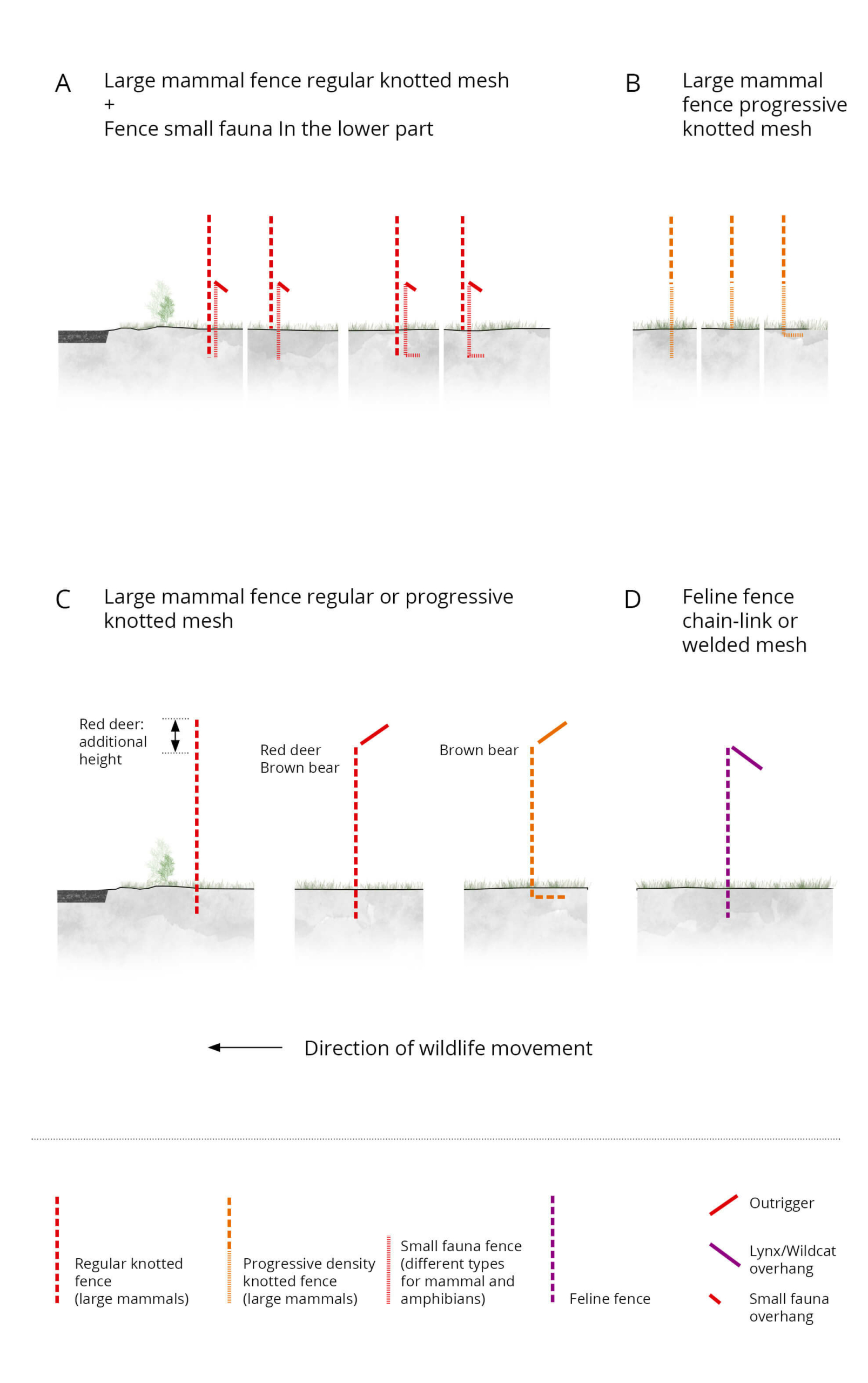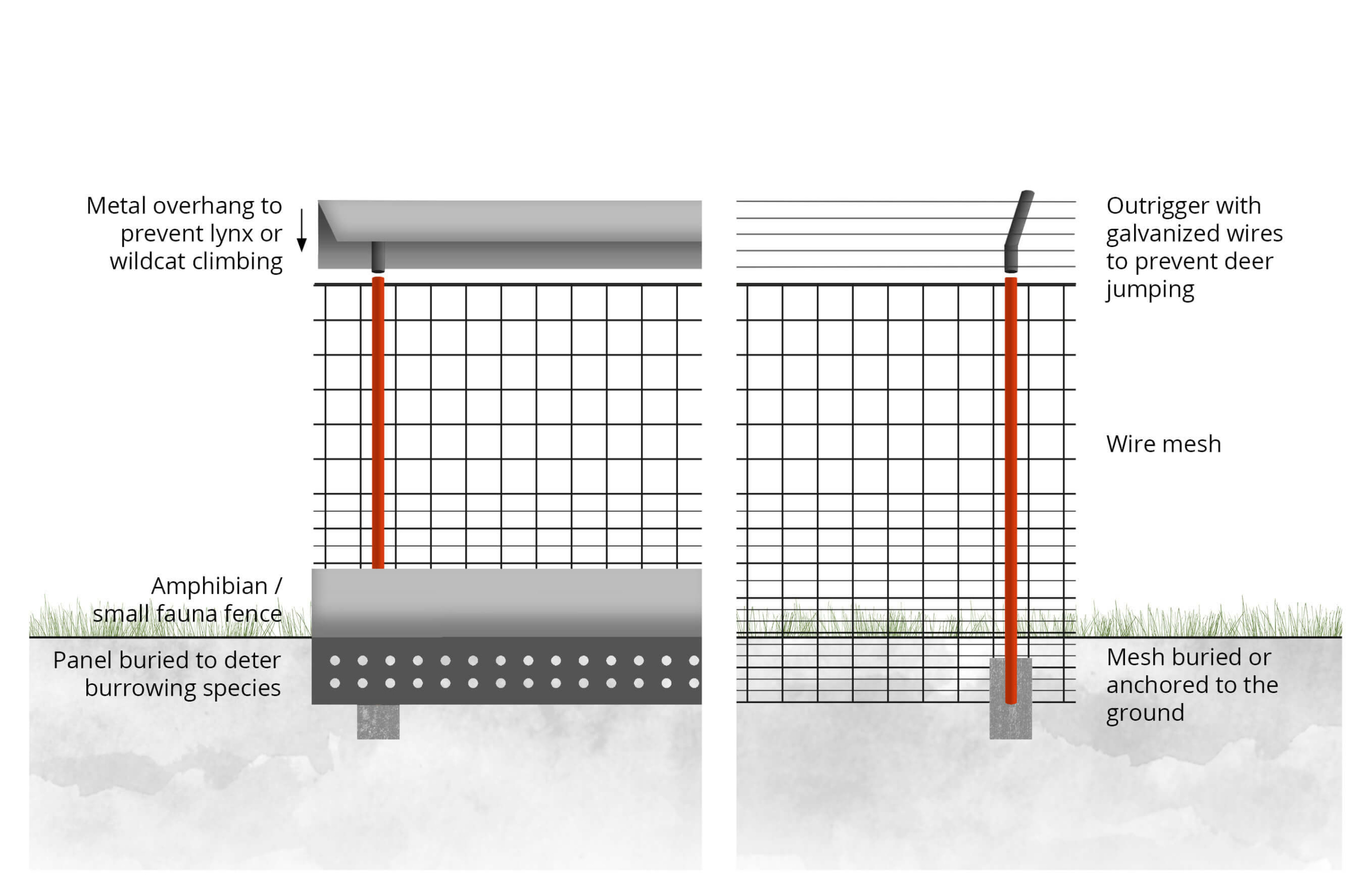The type of fence to be installed should take account of main target species to be excluded from the infrastructure and must be designed accordingly.
The mesh, or any other fence material, should be fixed on the outside of the poles (i.e., away from the road) to prevent a large animal being able to bring down the mesh by pushing its attachments to breaking point.
Wire mesh is the standard material applied in wildlife fencing where large mammals (ungulates and carivores, including mid-sized species such as wildcat, badger, and martens) are the target. Three types of wire mesh are often used (Figure 5.2.9): knotted mesh (regular or progressive density), chain-link mesh and welded mesh. Several dimensions of mesh and wires are provided by manufacturers. Knotted mesh is the standard for large mammals but it could pose a risk for felines with reports of specific cases of wildcats being trapped in this type of wire mesh. Chain-link is not suitable where wild boar is a concern because this species can deform it and open holes. Welded mesh is safe for all types of fauna, and is particularly strong and suitable in areas requiring maximum resistance, but it is more costly. Balancing efficiency and cost is crucial in choosing the most suitable mesh type.

Other materials such as steel or concrete are also recommended to deter small fauna (such as amphibians and reptiles) -particularly climbing species- and to avoid harming them (Figure 5.2.10). Materials that do not have long durability or produce high amounts of plastic waste should be avoided. Nevertheless, polymers of recycled plastic which have been guaranteed to be durable may be suitable for small fencing reinforcements (see Section 5.2.4 – Fencing and reinforcements for small vertebrates and Section 5.2.5 – Adaptation of existing fences and other systems to deter burrowing animals).

Fences must be strong and durable enough to resist attempts by wildlife to break through. A rectangular knotted mesh fence with a wire made of stainless materials (galvanized) and with a diameter of at least 2.5 mm is the standard wildlife fence recommended for large mammals (ungulates and large carnivore). In areas with heavy snowfall, the top netting wire must be reinforced with a cable capable of bearing the weight of snow settling on it.
The dimension of the mesh (Table 5.1) is determined by the size of the animals it should stop and their ability to squeeze through it, not forgetting juvenile animals which may end up getting through. Standard wire mesh density is generally 15×15 cm, because ungulates are the largest target mammals in many areas.
Knotted wire mesh of progressive density (wider at the top) is recommended for large mammals, particularly ungulates, and can also prevent medium-sized mammals like foxes or badgers from crossing (Figure 5.2.7).
The lower part of the mesh should be buried in the ground to combat digging animals (such as wild boar, badger and fox). Mesh can also be extended horizontally to prevent brown bear getting through. Alternatively, ground pegs have been recommended to fix the mesh to the ground, even if the effectiveness of this measure depends on soil hardness and other factors. Welded mesh reinforcements could be installed when burrowing animals overcome existing fencing (see Section 5.2.4 – Fencing and reinforcements for small vertebrates and Section 5.2.5 – Adaptation of existing fences and other systems to deter burrowing animals).
Different types of fences could be combined to adapt fencing to target species requirements. The combinations most frequently applied for large mammals in Europe are shown in Figure 5.2.11 and examples in Figure 5.2.12. Note that these are not suitable for amphibians and reptiles.


Modular fencing is being applied in some countries, consisting of different panels that could be assembled according to target species in the area (Figure 5.2.13). They could integrate 1) outrigger panels preventing access by climbing species (mesh, metal sheets, or even floppy overhangs in specific cases); 2) chain-link, knotted or standard mesh panels, and 3) opaque buried panels to prevent access by burrowing species as well as amphibians and reptiles.
